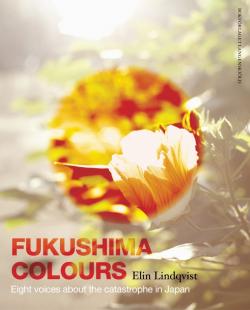Fukushima Colours

By Elin Lindqvist, Published by Langenskiöld (see note at bottom), 2012, ISBN: 978-91-87007-04-0
Review by Ali Muskett
Elin Lindqvist, journalist and author of three novels in Swedish, was born in Japan in 1982 and lived there for two years as a child. She currently lives in England, but has maintained a strong connection with Japan, having spent further time there in her teens and twenties.
Immediately after the triple catastrophe of earthquake, tsunami and nuclear disaster on 11 March 2011, Elin was moved to travel to Japan. She felt she needed to be there to see things for herself, and to report on the situation in a fair and honest way, which she thought the Western media was not doing. Many would agree that the Western media sensationalised certain aspects of the disaster – especially the situation at the Fukushima Daiichi nuclear plant – and Elin was determined to find out what things were really like in Tohoku (the north-eastern region of Honshu, the main island of Japan). In March 2011 Elin wrote for the largest Swedish daily newspaper, Aftonbladet, and she returned in May 2011 to write about the reconstruction process and continuing nuclear crisis for newspapers Aftonbladet and Svenska Dagbladet.
Fukushima Colours is the result of a number of visits to Japan in the months following the disaster, and went to print 10 months after Elin’s initial visit. Elin was accompanied by photographer Yoshikazu Fukuda and journalist Yuko Ota, and together they spoke to people affected by the catastrophe in different ways. The eight individuals, or groups of individuals, who feature in this book were all affected by the earthquake, tsunami and nuclear crisis even though some of them do not live in the Tohoku region itself. Personal accounts come from organic farmers talking about the effects of the disaster on the agricultural industry and ways in which renewable energy can be used in the future, the founder and president of the aid organisation CRASH (a Christian volunteer group with which Elin volunteered, despite not being Christian), a fish and seafood restaurant owner and intermediate wholesaler at Tsukiji fish market in Tokyo, an oyster farmer, the managing director of a Honda car dealership and garage, a beef farmer (who is also the Lord of Soma, and creator of the volunteer organisation Soma Aid) and a couple of housewives, concerned about bringing up their children in world of uncertainty and possible radioactive contamination.
The book is beautifully designed, and the simple phrases (such as ‘我慢 GAMAN Endure the seemingly unbearable with patience and dignity’) which separate the chapters give the reader a moment to pause and reflect on each account. Fukushima Colours isn’t quite what I had expected it to be, but that isn’t necessarily a negative comment on the book. Personally, I had hoped to read the translated accounts directly from the mouths of those affected, but what I actually found was a book which contained Elin’s voice throughout, as a kind of guiding voice and narrator. It was, at times, difficult to know if the words were Elin’s or the interviewee’s, and I felt that the tone of the book was set by the author’s voice rather than the voices of the people I really wanted to hear from.
I believe the purpose of the book was to remember the lives lost in the triple disaster, but also to look to the future through the eyes of the people who survived and are trying to reconstruct their lives. I did, however, feel that the overall ‘message’ of the book was unclear, and reflected the great uncertainty in Japan at the time of the interviews. The oyster farmer’s wife comments, ‘the colour of the sea water is different than it used to be before the tsunami,’ but no one knows what this means. A certain sense of fear comes through in some accounts, and for me this fear and uncertainty formed a heavy cloud over the book, blocking out the bright colours of the future that I think it hoped to show.
Notes
Fukushima Colours has been published in both English and Swedish (Swedish title: Fukushimas Färger), to find out about the book’s availability see: http://elinlindqvist.com/2012/06/25/to-buy-fukushima-colours/

